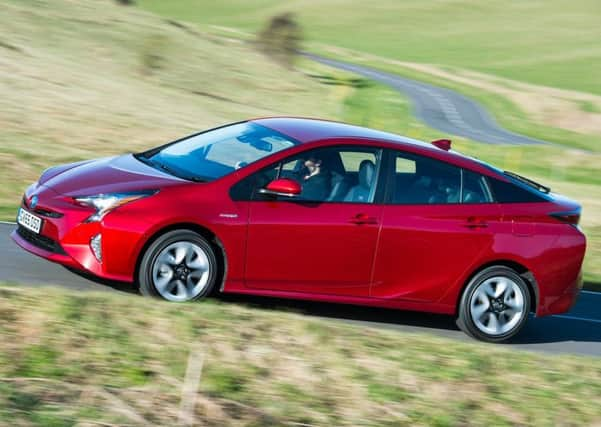Review: Toyota Prius hybrid is a marvel of green technology


Valencians went about their morning – some at pavement cafés which celebrated the advantages of mild winter mornings in Spain. We teetered quietly up and down calles and avenidas and through plazas.
The electric motor in the Toyota Prius had an audible whine at these urban speeds but the good news was that with the petrol engine not needed, the car was causing no pollution. Petrol power kicked back seamlessly when a burst of speed was advisable to exit a junction and avoid being skewered by a scooter.
Advertisement
Hide AdThis was part of Toyota’s European press debut for the latest, better Prius, easily the world’s best-selling hybrid-engined car. We were not the only Prius drivers: the Prius is a common taxi in Valencia.
This latest Prius was so smooth and responsive and silent that we almost needed the roar of an engine to punctuate our lostness. The super slick automatic gearbox stitched the power units together seamlessly. The electric motor, powered by its own constantly regenerating battery, runs all the time and takes over completely for reversing. The recharge comes from the petrol engine and the braking and deceleration of the car.
It’s a sector Toyota pioneered with Honda and has dominated. Since the first Prius 19 years ago, it has sold more than 8.5 million hybrids, including 1.2 million last year – which accounted for 60 per cent of all hybrids. Of the total, almost a million are Lexus models. The Prius total is 3.5 million.
Most are made in Japan, but the Yaris and Auris hybrids are made in Northern France and near Derby, with a £7 million expansion of its North Wales engine factory to make hybrid engines for a new small SUV being built in Turkey.
The thinking behind hybrid-engined vehicles is that they give better fuel economy and lower emissions. Most of them are petrol/electric (Peugeot and Citroën use diesel/electric) and can rival the economy of a diesel engine with lower CO2 and an absence of diesel-induced tail pipe toxins. Toyota reckons its hybrids have saved 58 million tons of CO2. One million Toyota and Lexus hybrids have been sold in Europe, so that’s around 6.8 million tons of CO2 saved by its hybrids there.
Eventually we broke free of Valencia, having lapped the fabulous water park and exhibition halls which make up what Valencians call the Ciutat de les Arts i les Ciències – which even I can translate.
Advertisement
Hide AdHola, here we are, gone from the thrall of the city and on the road, north-west in the direction of Cuenca, relying absurdly on the car’s navigator. Yes, we were to get wrong-slotted several more times and one journalist almost missed his flight home. The last I heard, Toyota boffins had the Prius navigator under scrutiny. Software, tut tut.
The Prius held its own in the flurry of the autopista and its higher power, the weight reduction and lower stance make it handle and go better than the last model. We found our way to one of those handsome Spanish farms built round a courtyard, serving coffee and cake. Ripe lemons and oranges were in the orchards, massive barrels in its cave ready for wine. It just needed a Don Quixote or Laurie Lee to give it a literary context. OK, here goes: “As I drove out one Valencian morning…”
Advertisement
Hide AdAs for this Prius, its context is the next generation of hybrid technology, which will transfer into other models. The more powerful battery pack is lighter and smaller and allows normal luggage space.
Like the previous models it is a bespoke hybrid – no other power are offered. In the first Prius, although purpose built, the rear seat would not fold away because of the location and size of the battery.
There are improvements in all areas, from the petrol engine to the faster steering, from the cabin ergonomics to the suspension comfort.
With 15-inch wheels the CO2 emissions are 70g, meaning no London congestion charges and maximum tax write-down for businesses. Models with 17-inch alloys – which were on the test cars – emit 76g CO2, one gram over the tax-free limit. They have wider, sportier tyres for sportier driving, but can be specified with 15-inch wheels, saving £400 off the list price. The car’s suspension and diagnostics are set for specific wheel and tyre sizes, so after-sale switching to the 17-inch wheel is not advised.
The range starts at £23,295 for the Active, which has dual zone air con, LED headlights with smart high beam operation, touch screen, DAB, forward collision warning with emergency braking, adaptive cruise control, road sign recognition and lane departure warning.
The next grade is Business Edition at £24,195, followed by a Plus version with navigation and connectivity, the 17-inch wheels and parking assistance at £25,995. The Excel has all the above plus leather, JBL audio and automatic wipers – and a leap to £27,450.
Verdict: Costs more to buy than a conventional car but gives more, too, and is cheaper to own. Usual long Toyota warranty applies.